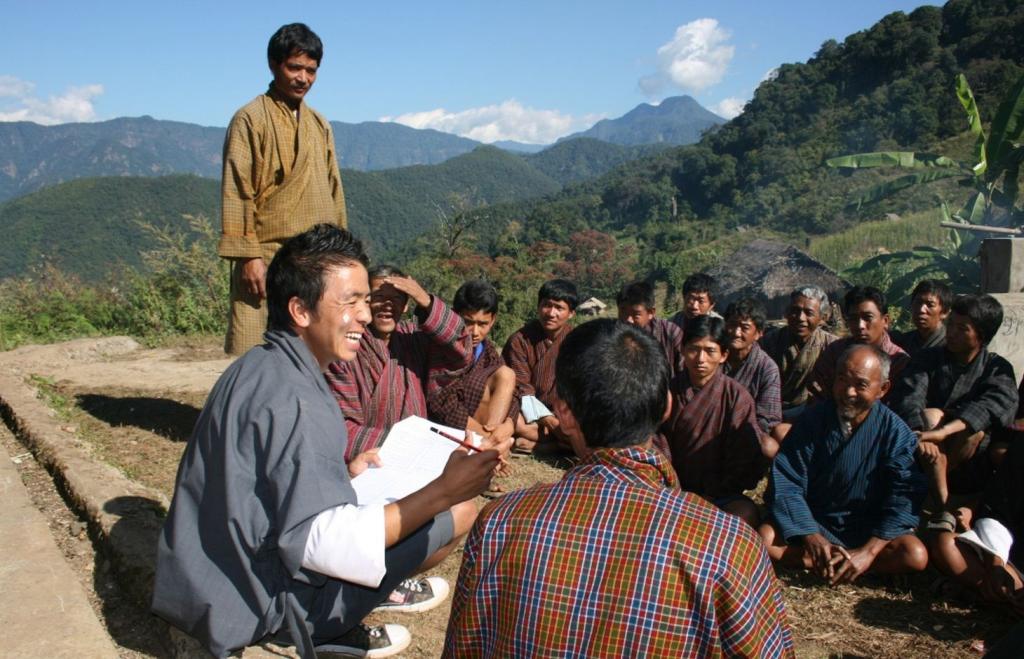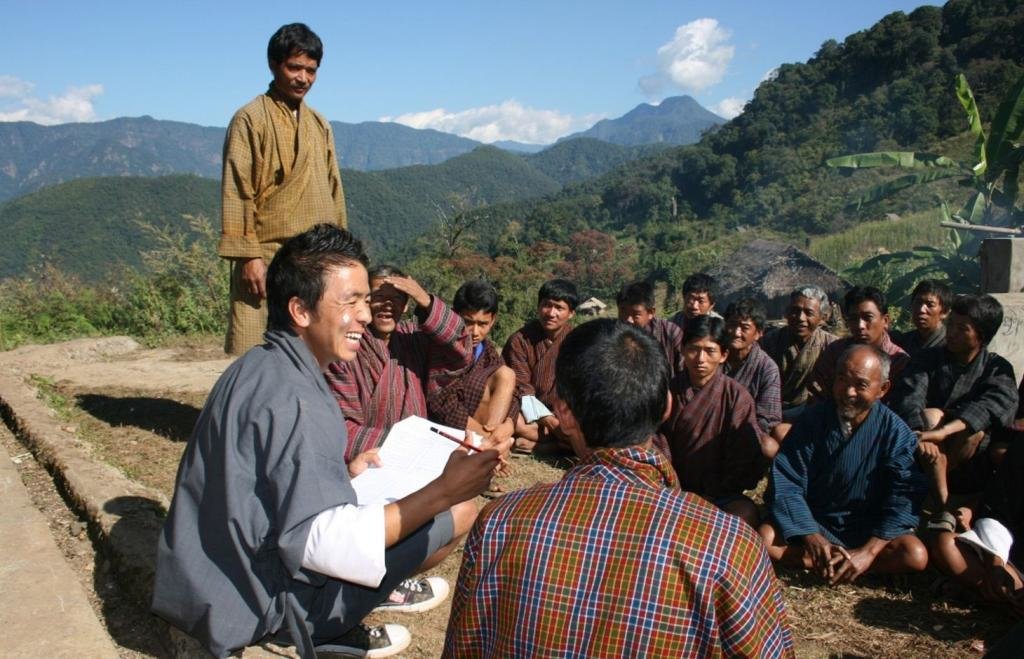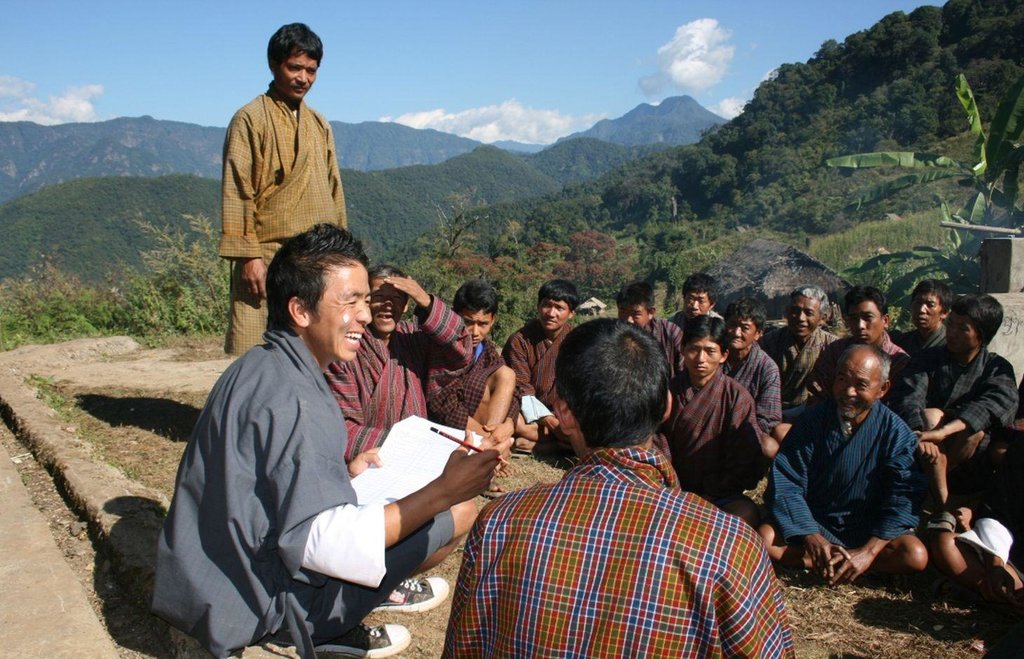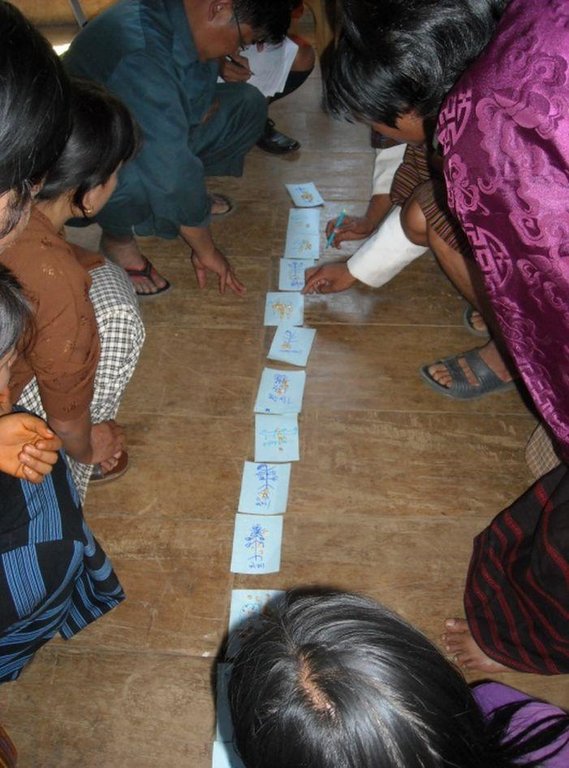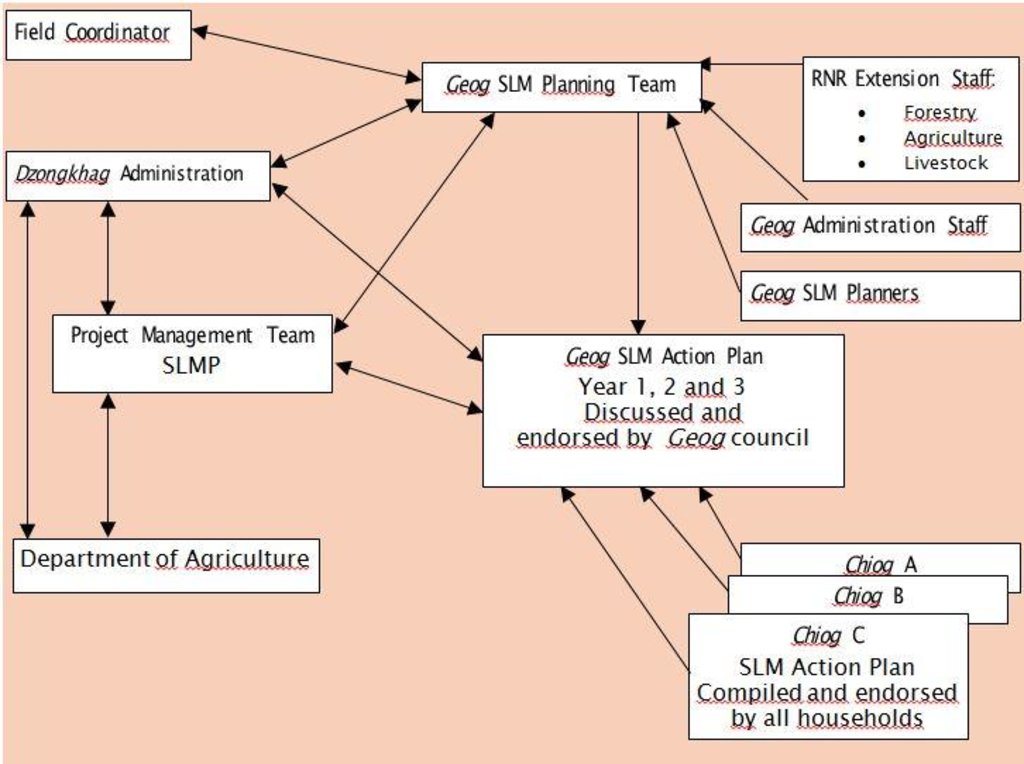Participatory SLM Action Planning [بوتان]
- تاريخ الإنشاء:
- تحديث:
- جامع المعلومات: Karma Dorji
- المحرر: –
- المُراجع: Fabian Ottiger
approaches_2489 - بوتان
عرض الأقسام
توسيع الكل طي الكل1. معلومات عامة
1.2 تفاصيل الاتصال بالأشخاص الرئيسيين لمصدر المعلومات والمؤسسات المعنية بتقييم وتوثيق النهج
متخصص في الإدارة المستدامة للأراضي:
Wangdi Tashi
NSSC, DoA, MoAF, RGoB
بوتان
متخصص في الإدارة المستدامة للأراضي:
Dorji Tshering
NSSC, DoA, MoAF, RGoB
بوتان
اسم المؤسسة (المؤسسات) التي سهلت توثيق/تقييم النهج (إذا كان ذلك على صلة)
National Soil Services Centre (National Soil Services Centre) - بوتاناسم المؤسسة (المؤسسات) التي سهلت توثيق/تقييم النهج (إذا كان ذلك على صلة)
MoA (MoA) - بوتان1.3 الشروط المتعلقة باستخدام البيانات الموثقة من خلال WOCAT
متى تم تجميع البيانات (ميدانيا)؟:
14/03/2011
يوافق جامع المعلومات والشخص (لاشخاص) الرئيسي لمصدر المعلومات على الشروط المتعلقة باستخدام البيانات الموثقة من خلال WOCAT:
نعم
2. وصف نهج الإدارة المستدامة للأراضي
2.1 وصف موجز للنهج
A methodology to identify in a participatory manner at village level land-based problems, its causal factors and mitigation measures to reduce land degradation and enhance rural livelihoods
2.2 وصف تفصيلي للنهج
وصف تفصيلي للنهج:
Aims / objectives: Participatory SLM Action Planning (SLM AP) is a methodology that aims at prioritiz-ing possible SLM interventions to mitigate the most critical land degradation issues. Priorities are based on the identification of land-based livelihoods and livelihood resources, the key area-based problems and their causes. SLM AP is carried out in the SLMP geogs (block) at chiog (village) level, including all community households. It involves elements of PRA/PLA such as problem census, cropping calendars, history lines, natural resource mapping and builds on the in-depth knowledge and understanding of farming households of their land, their problems and opportunities. The process is highly visual to include the illiterate and very interactive by giving the communities the lead in prioritizing their problems and deciding on SLM interventions.
Methods: The SLM AP is an iterative process, starting with building and training SLM planning teams (GSPTs) at geog level, comprising of extension staff and locally recruited geog SLM planners (GSPs) and geog administration staff. The GSPTs start awareness and mobilization activities in the first year at geog council level. This is followed by a 3 day SLM AP in each and every chiog of the geog to compile a chiog SLM action plan. The village SLM APs are combined into a geog SLM AP and discussed, amended and endorsed in a public meeting by the geog council. The necessary budget is allocated by SLMP project and implementation of the planned activities takes place at chiog level.
Stages of implementation: Implementation is preceded by intensive training and capacity building of the communities in SLM activities. In the second year a new SLM AP round is made, lasting only one day, with review of the previous SLM AP at chiog level. Potential new activities are identified, based on field experiences, to complete the new SLM AP for year 2. In the final year 3, a last SLM AP round is made in all chiogs to compile chiog and ultimately a geog SLM AP.
Role of stakeholders: SLM AP is an inclusive process and gender sensitive, with focus on vulnerable households. The approach includes participatory Natural Resource mapping at chiog level and participatory Monitoring & Evaluation to track implementation progress and impact and to get feedback of the communities.
Other important information: Environmental and social screening procedures are applied to exclude any negative impact on the land or on social groups. SLM AP was piloted in 3 geogs in 3 Dzongkhags since 2006 and has been rolled out to more than 130 chiogs in 9 geogs.
2.3 صور عن النهج
2.5 البلد/المنطقة/المواقع التي تم تطبيق النهج فيها
البلد:
بوتان
المنطقة/الولاية/المحافظة:
Chhukha, Trashigang and Zhemgang Dzongkhags
مزيد من التفاصيل حول الموقع:
9 separate geogs
2.6 تواريخ بدء وإنهاء تنفيذ النهج
أشر إلى سنة البدء:
2006
سنة الإنهاء (إذا لم يعد النهج مطبقًا):
2012
2.7 نوع النهج
- قائم على مشروع/برنامج
2.8 الغايات/الأهداف الرئيسية للنهج
The Approach focused mainly on SLM with other activities (livelihoods, cash income, food security, capacity building, awareness raising)
- To build community capacity to assess land degradation and identify and prioritize mitigation measures
- Enhancement of rural livelihoods
The SLM Approach addressed the following problems: - Lack of awareness of land degradation processes, combined with limited technical knowledge to tackle its causes.
- Planning procedures are top-down and do not incorporate land-based issues adequately and fail to build local ownership and sustainability.
2.9 الظروف التي تمكن أو تعيق تنفيذ التقنية/التقنيات المطبقة بموجب النهج
توفر/الوصول إلى الموارد والخدمات المالية
- معيق
Large amount of cash to handle at municipality level
Treatment through the SLM Approach: Training, monitoring and limitation of cash amounts
الإطار المؤسساتي
- معيق
Delays in financial releases to decentralised level because of lengthy/complicated administrative chain
Treatment through the SLM Approach: Training of key financial staff to shorten procedure and minimize frequency of budget releases
الإطار القانوني (حيازة الأراضي، وحقوق استخدام الأراضي والمياه)
- تمكين/تمكيني
The existing land ownership, land use rights / water rights helped a little the approach implementation: Individual land titles of households favour greatly the planning and implementation of SLM activities
- معيق
Lack of efforts in implementing SLM technologies on land without ownership and living as tenants
Treatment through the SLM Approach: Awareness on the importance of proper management to prevent decline in productivity and their own livelihoods through loss of soil fertility and or loss of land physically due to landslides and mass movements.
المعرفة حول الإدارة المستدامة للأراضي، والوصول إلى الدعم الفني
- معيق
Awaraness of communities and technical confidence of teams
Treatment through the SLM Approach: Training and capacity buidling
عبء العمل، توفر القوى العاملة
- معيق
Large volume of work, especially in growing season
Treatment through the SLM Approach: Make of use of lean winter season for labour-intensive SLM interventions
غير ذلك
- معيق
Small land holding sizes to spare a portion for SLM technologies
Treatment through the SLM Approach: Awareness on the advantages of SLM
3. المشاركة وأدوار الأطراف المعنية
3.1 أصحاب المصلحة المعنيون بالنهج وأدوارهم
- مستخدمو الأراضي المحليون/المجتمعات المحلية
communities of all chiogs
In all villages the most vulnerable community members were identified (wealth / well-being ranking), ranked and specific effort made to include them in most interventions, where possible.
- متخصصون في الإدارة المستدامة للأراضي / مستشارون زراعيون
- المعلمون / أطفال المدارس / الطلاب
- الحكومة المحلية
GSPT and Dzongkhag staff (Local government)
- الحكومة الوطنية (المخططون، صانعو القرار)
RGoB, MoAF, DoA
- منظمة دولية
GEF, World Bank
- monk body
3.2 انخراط مستخدمي الأراضي المحليين/المجتمعات المحلية في المراحل المختلفة للنهج
| انخراط مستخدمي الأراضي المحليين/المجتمعات المحلية | حدد من شارك وصف الأنشطة | |
|---|---|---|
| المبادرة/التحفيز | تفاعلي | National level stakeholders in consultation with district and municipality staff developed the methodology through an iterative consultation process |
| التخطيط | تفاعلي | Decentralised training and planning of SLM interventions at chiog level (130+ chiogs) in 9 geogs in 3 Dzongkhags |
| التنفيذ | تفاعلي | Range of SLM and livelihood activities at chiog level (130+ villages) during 6 year project period |
| الرصد/التقييم | تفاعلي | Regular participatory M&E at chiog and geog level |
| Research | سلبي | Few focused SLM related research topics commissioned to governmental research institutions |
3.3 مخطط التدفق (إذا كان متاحًا)
الوصف:
Overview of network of Stakeholders at chiog (village), geog and district level
المؤلف:
Hans van Noord (Schoutenkamp 43 Heteren The Netherlands)
3.4 اتخاذ القرار بشأن اختيار تقنية/تقنيات الإدارة المستدامة للأراضي
حدد من الذي قرر اختيار التقنية/التقنيات التي سيتم تنفيذها:
- مستخدمو الأراضي بشكل أساسي، بدعم من متخصصي الإدارة المستدامة للأراضي
اشرح:
Decisions on the method of implementing the SLM Technology were made by mainly by SLM specialists with consultation of land users. The SLM planning was done in a very participatory manner with the land users as they best know the problems in their land i.e. where, how, when, etc. Planning done using participatory planning tools and field visits. Based on the problems at the site (site specific problems) then SLM Specialists make problem specific recommendations of SLM technologies. The main Monitoring and Evaluation was done after every six months when comprehensive information was collected with structured questionnaires along with site visits and meeting with the communities. M&E was also done as frequently as possible even while visiting the site for other purposes during the year without compulsory group meetings.
4. الدعم الفني وبناء القدرات وإدارة المعرفة
4.1 بناء القدرات/التدريب
هل تم تقديم التدريب لمستخدمي الأراضي / الأطراف المعنيين الآخرين؟:
نعم
حدد من تم تدريبه:
- مستخدمو الأراضي
- موظفون ميدانيون/ مستشارون
- Project management staff
شكل التدريب:
- في العمل
- من مزارع إلى مزارع
- مناطق العرض
- اجتماعات عامة
- دورات
المواضيع المغطاة:
Extensive training programmes for project management staff and field coordinators and the decentralised extension staff (forestry, livestock and agriculture) at geog level together with the geog administration staff and finally to all chiog communities (130+). Initial training was on SLM action planning and Natural Resource mapping; later on a range of technical intervention such as hedgerow establishment, check dam construction, bioengineering, afforestation, community forestry, fodder development, bamboo plantation, bench terracing etc.
4.2 خدمة استشارية
هل يملك مستخدمو الأراضي وصولا إلى خدمة استشارية؟:
نعم
حدد ما إذا كانت الخدمة الاستشارية متوفرة:
- في حقول مستخدمي الأراضي
وصف/تعليقات:
Name of method used for advisory service: SLM planning knowledge transfer; Key elements: participatory planning, capacity and skills building of RNR extension staff; Whole range of extension advisory services by all extension teams related to SLM, cash generation and group formation
Advisory service is quite adequate to ensure the continuation of land conservation activities; Capacity built, awareness raised, institutions supported. Adequate human and institutional capacities and awareness have been created during the GEF/World Bank SLM Project period and the effort is still being continued. The actual implementation of the SLM technologies in the field is constrained by inadequate fund support and small land holdings.
4.3 تعزيز المؤسسات (التطوير التنظيمي)
هل تم إنشاء أو تعزيز مؤسسات من خلال هذا النهج؟:
- نعم، قليلا
حدد المستوى (المستويات) التي تم فيها تعزيز أو إنشاء المؤسسات:
- محلي
حدد نوع الدعم:
- بناء القدرات/التدريب
- معدات
- curriculum development support, seeds, seedlings
اعط مزيدا من التفاصيل:
Moderate support to monk body, schools, Non-Formal Education and geog administrations
4.4 الرصد والتقييم
هل يشكل الرصد والتقييم جزءا من النهج؟:
نعم
التعليقات:
bio-physical aspects were regular monitored by project staff through observations; indicators: Regular measurements and observations of acreage of improved vulnerable land through SLM interventions; annual soil erosion plot measurements
bio-physical aspects were regular monitored by project staff through measurements; indicators: Regular measurements and observations of acreage of improved vulnerable land through SLM interventions; annual soil erosion plot measurements
technical aspects were regular monitored by project staff through observations; indicators: Regular measurements and observations of acreage and properties of specific areas of improved vulnerable land
technical aspects were regular monitored by project staff through measurements; indicators: Regular measurements and observations of acreage and properties of specific areas of improved vulnerable land
socio-cultural aspects were regular monitored by project staff, land users through observations; indicators: Regular observations through participatory M&E meetings
economic / production aspects were regular monitored by project staff through observations; indicators: Regular observations and measurements by field extension staff (crop cut, animal production, volume of bamboo marketed; CBA study to establish economic viability
economic / production aspects were regular monitored by project staff through measurements; indicators: Regular observations and measurements by field extension staff (crop cut, animal production, volume of bamboo marketed; CBA study to establish economic viability
area treated aspects were regular monitored by project staff, land users through measurements; indicators: Regular measurements of area treated: range of project indicators for vulnerable land improved
no. of land users involved aspects were ad hoc monitored by project staff, government through measurements; indicators: Regular measurements of households and farmers (male/female) participating
management of Approach aspects were regular monitored by None through observations; indicators: WB, MTAC, Regular reviews with key stakeholders (Annual Review Workshops)
There were several changes in the Approach as a result of monitoring and evaluation: Two-tier approach: combination of inclusion of all household combined with limited areal focus; vulnerable households focus; financial disbursement system; ch more cash-generating activities; more group/community focus; labour-saving machinery
There were few changes in the Technology as a result of monitoring and evaluation: change of type and variety of seeds and seedlings
4.5 البحوث
هل كانت البحوث جزءًا من النهج؟:
نعم
حدد المواضيع:
- علم الاجتماع
- الاقتصاد / التسويق
- علم الايكولوجيا
أعط تفاصيل إضافية وأشر إلى من قام بالبحوث:
Little involvement, apart from some focused research on group formation at chiog level and studies on CBA, SLM-poverty linkage, rangeland management, rural-urban transition etc.
Research was carried out both on station and on-farm
5. التمويل والدعم المادي الخارجي
5.1 الميزانية السنوية لمكون الإدارة المستدامة للأراضي في النهج المذكور
إذا لم تكن الميزانية السنوية الدقيقة معروفة، قم بالإشارة إلى نطاقها:
- > 1,000,000
التعليقات (على سبيل المثال المصادر الرئيسية للتمويل/الجهات المانحة الرئيسية):
Approach costs were met by the following donors: international (GEF-World Bank): 70.0%; government (RGoB): 20.0%; local community / land user(s): 10.0%
5.2 الدعم المالي/المادي المقدم لمستخدمي الأراضي
هل حصل مستخدمو الأراضي على دعم مالي/ مادي لتنفيذ التقنية/ التقنيات؟:
نعم
إذا كانت الإجابة بنعم، حدد نوع (أنواع) الدعم والشروط والمزودين:
Incentives for specific SLM interventions per area and through short-term input support (seeds and seedlings)
5.3 إعانات لمدخلات محددة (بما في ذلك العمالة)
- معدات
| حدد المدخلات التي تم دعمها | إلى أي مدى | حدد الإعانات |
|---|---|---|
| أدوات | ممول جزئيا | |
- زراعة
| حدد المدخلات التي تم دعمها | إلى أي مدى | حدد الإعانات |
|---|---|---|
| بذور | ممول جزئيا | |
| Seedlings | ممول جزئيا | |
- بناء
| حدد المدخلات التي تم دعمها | إلى أي مدى | حدد الإعانات |
|---|---|---|
| for fencing and dams | ممول جزئيا | |
- بنى تحتية
| حدد المدخلات التي تم دعمها | إلى أي مدى | حدد الإعانات |
|---|---|---|
| FYM sheds, irrigation channel renovation | ممول جزئيا | |
التعليقات:
Mostly voluntary and some paid in cash (for labour-intensive SLM interventions) and limited other material support such as tools and seeds and seedlings
Not financed: roads, fertilizers, schools
5.4 الائتمان
هل تم توفير ائتمان في إطار نهج أنشطة الإدارة المستدامة للأراضي؟:
كلا
6. تحليل الأثر والتصريحات الختامية
6.1 آثار النهج
هل ساعد النهج مستخدمي الأراضي على تنفيذ وصيانة تقنيات الإدارة المستدامة للأراضي؟:
- لا
- نعم، قليلا
- نعم، باعتدال
- نعم، إلى حد كبير
Considerable area of vulnerable land brought under SLM, reduction of loss of land, improved yields, improved income, improved animal production, improved fodder base
هل ساهم النهج في تمكين الفئات المحرومة اجتماعيا واقتصاديا؟:
- لا
- نعم، قليلا
- نعم، باعتدال
- نعم، إلى حد كبير
Moderate improvement of vulnerable households (poorest and single-headed households) through targeted interventions and pro-active inclusion. The labour sharing approach in implementing SLM activities greatly benefited the resource (human and capital) constrained household.
هل أدى النهج إلى تحسن في مسائل حيازة الأراضي / حقوق المستخدمين التي أعاقت تنفيذ تقنيات الإدارة المستدامة للأراضي؟:
- لا
- نعم، قليلا
- نعم، باعتدال
- نعم، إلى حد كبير
The problem is unlikely to be overcome in the near future. Individual land titles of households favour greatly the planning and implementation of SLM activities
Did other land users / projects adopt the Approach?
- لا
- نعم، قليلا
- نعم، باعتدال
- نعم، إلى حد كبير
Other government and donor-funded projects have adopted elements of the participatory SLM action planning methodology (DANIDA, REAP)
Did the Approach lead to improved livelihoods / human well-being?
- لا
- نعم، قليلا
- نعم، باعتدال
- نعم، إلى حد كبير
cash income, food self-sufficiency, community sense/bonding, reduced exposure to natural hazards related to land degradation/flooding
Did the Approach help to alleviate poverty?
- لا
- نعم، قليلا
- نعم، باعتدال
- نعم، إلى حد كبير
Improvement of food self-sufficiency and cash generation opportunities
6.2 المحفز الرئيسي لقيام مستخدمي الأراضي بتنفيذ الإدارة المستدامة للأراضي
- زيادة الإنتاج
- انخفاض عبء العمل
- المدفوعات/ الإعانات
- الوجاهة والضغط الاجتماعي/التماسك الاجتماعي
- الانتماء إلى حركة/ مشروع/ مجموعة/ شبكات
- الوعي البيئي
- well-being and livelihoods improvement
6.3 استدامة أنشطة النهج
هل يمكن لمستخدمي الأراضي المحافظة على استدامة ما تم تنفيذه من خلال النهج (بدون دعم خارجي)؟:
- غير مؤكد
إذا كان الجواب لا أو غير متأكد، حدد ذلك وعلق عليه:
Rural communities will need continued support by government staff through advice, finance and other support.
6.4 نقاط قوة/مزايا النهج
| نقاط القوة/ المزايا/ الفرص من وجهة نظر جامع المعلومات أو غيره من الاشخاص الرئيسيين لمصدر المعلومات |
|---|
|
Decentralised, village level bottom-up planning and implementation ensures capacity building, ownership and empowerment of rural land users Participatory character gives a voice to farmers with in-depth knowledge of land-based issues and its causes and history Inclusiveness of approach, reaching to all households Helps to build community sense (How to sustain/ enhance this strength: Continued annual AP Continued annual AP; add with NR mapping and ITK studies and participatory M&E Continued annual AP; targeted focus on most vulnerable households Additional group formation and community group support ) |
6.5 نقاط الضعف/ العيوب في المنهج وطرق التغلب عليها
| نقاط الضعف/ المساوىء/ المخاطر من وجهة نظر جامع المعلومات أو غيره من الاشخاص الرئيسيين لمصدر المعلومات | كيف يمكن التغلب عليها؟ |
|---|---|
|
Time-consuming and resource demanding Requires large workload of both extension staff and farmers Costly as the approach also covers actual implementation of all of planned SLM activities and reaches more than 130 villages for 3 year period |
Combine and align with Five Year Plan planning procedures; mainstreaming into governmental decentralised planning procedures Mainstreaming into regular planning and budgeting Spread over calendar year; labour-intensive SLM activities in lean winter season. |
7. المراجع والروابط
7.1 طرق جمع/مصادر المعلومات
- زيارات ميدانية، مسوحات ميدانية
- مقابلات مع مستخدمي الأراضي
7.2 المراجع للمنشورات المتاحة
العنوان، المؤلف، السنة، النظام القياسي الدولي لترقيم الكتب ISBN:
Working the Land - Documenting the Key Lessons of Sustainable Land Management on Steep to Very Steep Slopes in Bhutan 2011
متاح من أين؟كم التكلفة؟:
NSSC, DoA, MoAF, RGoB
العنوان، المؤلف، السنة، النظام القياسي الدولي لترقيم الكتب ISBN:
Indigenous Technical Knowledge (ITK) on Soil & Soil Fertility Management 2011
متاح من أين؟كم التكلفة؟:
NSSC, DoA, MoAF, RGoB
العنوان، المؤلف، السنة، النظام القياسي الدولي لترقيم الكتب ISBN:
Participatory Approaches in Sustainable Land Management – Planning, Implementation & Monitoring as Continuous Learning Processes 2011
متاح من أين؟كم التكلفة؟:
NSSC, DoA, MoAF, RGoB
العنوان، المؤلف، السنة، النظام القياسي الدولي لترقيم الكتب ISBN:
National Action Plan to Combat Land Degradation 2010, 2014
متاح من أين؟كم التكلفة؟:
NSSC, DoA, MoAF, RGoB
العنوان، المؤلف، السنة، النظام القياسي الدولي لترقيم الكتب ISBN:
BHUCAT, Best Practices and Guidelines from Bhutan for SLM on Steep to very Steep Slope
متاح من أين؟كم التكلفة؟:
NSSC, DoA, MoAF, RGoB
العنوان، المؤلف، السنة، النظام القياسي الدولي لترقيم الكتب ISBN:
Documentary of the achievements made in SLM through SLM Project
متاح من أين؟كم التكلفة؟:
NSSC, DoA, MoAF, RGoB
العنوان، المؤلف، السنة، النظام القياسي الدولي لترقيم الكتب ISBN:
Bhutan Land Cover Assessment 2010-Technical Report, NSSC, 2011
متاح من أين؟كم التكلفة؟:
NSSC, DoA, MoAF, RGoB
العنوان، المؤلف، السنة، النظام القياسي الدولي لترقيم الكتب ISBN:
Soil Erosion – Measurement and analysis of soil erosion plot data, NSSC, 2010, 2011
متاح من أين؟كم التكلفة؟:
NSSC, DoA, MoAF, RGoB
العنوان، المؤلف، السنة، النظام القياسي الدولي لترقيم الكتب ISBN:
Integrated Biodiversity Survey of the Lower Wangchhu Watershed, Bhutan 2010
متاح من أين؟كم التكلفة؟:
NSSC, DoA, MoAF, RGoB
العنوان، المؤلف، السنة، النظام القياسي الدولي لترقيم الكتب ISBN:
Rangeland Management in Bhutan 2009
متاح من أين؟كم التكلفة؟:
NSSC, DoA, MoAF, RGoB, A consultancy report
العنوان، المؤلف، السنة، النظام القياسي الدولي لترقيم الكتب ISBN:
Study on Poverty Sustainable Land Management Linkages in Bhutan-A consultancy Report-2009 2009
متاح من أين؟كم التكلفة؟:
NSSC, DoA, MoAF, RGoB, A consultancy report
العنوان، المؤلف، السنة، النظام القياسي الدولي لترقيم الكتب ISBN:
Sustainable Land Management Participatory Action Planning Manual & Tool Kit 2009
متاح من أين؟كم التكلفة؟:
NSSC, DoA, MoAF, RGoB, A consultancy report
العنوان، المؤلف، السنة، النظام القياسي الدولي لترقيم الكتب ISBN:
Sustainable Land Management Interventions: Cost Benefit Analysis Report 2009
متاح من أين؟كم التكلفة؟:
NSSC, DoA, MoAF, RGoB, A consultancy report
العنوان، المؤلف، السنة، النظام القياسي الدولي لترقيم الكتب ISBN:
Rural Livelihoods and Peri-Urban Analysis 2008
متاح من أين؟كم التكلفة؟:
NSSC, DoA, MoAF, RGoB, A consultancy report
العنوان، المؤلف، السنة، النظام القياسي الدولي لترقيم الكتب ISBN:
Review of Mainstreaming of sustainable Land Management in Government Policies and Plans in Bhutan 2008
متاح من أين؟كم التكلفة؟:
NSSC, DoA, MoAF, RGoB, A consultancy report
الروابط والوحدات المواضيعية
توسيع الكل طي الكلالروابط
لا يوجد روابط
الوحدات المواضيعية
لا يوجد وحدات مواضيعية


